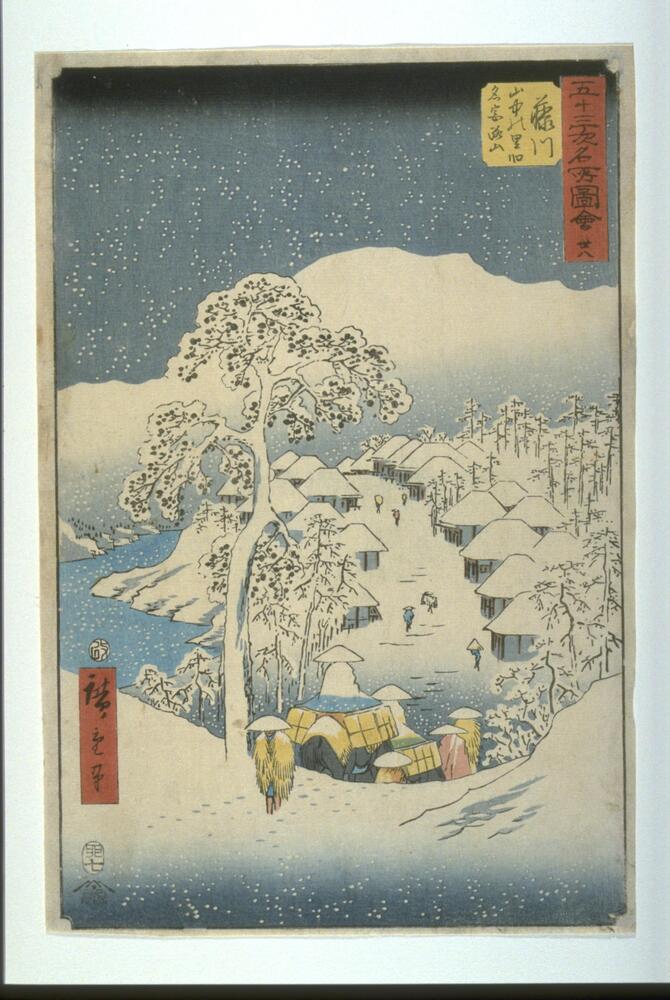Essay: Dow and Hiroshige
Although these two works are by different artists and separated by content, time and culture, and media they unexpectedly share something. Andô Hiroshige’s Famous View of Fifty-three Stages: Fujikawa is emblematic of the popular Japanese woodblock print style ukiyo-e. The work features the richly pigmented blocks of color and the graphic style characteristic of ukiyo-e. Nearly 40 years later, Arthur Wesley Dow painted Spring Landscape, a Post-Impressionistic look at a countryside vista. At first glance they seem totally different, but it will become apparent that they are linked.
Arthur Wesley Dow was born in 1857 to a modest family with strong roots in the British Isles. His upbringing in the family’s small hometown of Ipswich, Massachusetts would have a strong influence on his work throughout his career. Dow was late to start his work in the visual arts; his twenty-first birthday had come and gone before he began intently sketching the local houses in Ipswich. By 1884, at the age of twenty-seven, he decided to sail to France in order to pursue his career. He arrived in Paris and began his studies at the Académie Julian as well as the École des Beaux Arts while spending his Sundays surveying the great classical masterpieces in the Musée du Louvre.
Dow’s theories about aesthetics would eventually lead him to a successful career as a teacher. His 1899 book, Composition: A Series of Exercises in Art Structure for the Use of Students and Teachers introduces not only ideas about composition but also self-expression and was in print well into the 20th century. His student Georgia O’Keefe, herself a majorly successful artist, was inspired by his teachings on abstraction. American students of art today recognize Dow as one of the first great American teachers of fine art and painting.
Hiroshige is considered one of the last masters of ukiyo-e. He created several inventive series, like Fifty-three Stations of the Tōkaidō, which depict landscapes linked by a specific theme. Hiroshige, like his contemporary Hokusai, was also an influence for the Impressionists and later the Post-Impressionists. He was known for his elegant compositions that reduced the formal elements of the image into a distinct graphic style. In his works, he incorporated the Japanese concept of notan: the use of blocks of light and dark to create form and mass.
In terms of content, both the works feature landscape scenes. The Dow focuses on the ascension of spring by aligning the path, and the viewer’s perspective, with the horizon. Dow asks the viewer to look outward towards an unseen end. The Hiroshige, on the other hand directs the viewer to look inwards towards the center as the travellers descend into a village within his composition that is less linear.
More than content, we can see that Dow’s piece is influenced by the composition of Japanese woodblock prints. Note that both paintings employ a high horizon line. Both also have a central path leading toward the horizon, a common visual trope in Japanese and Chinese hanging scrolls. Dow, like Hiroshige, also uses the concept of notan to create a sense of depth. The images rely on broad areas of flat color. This, with the high horizon line, flattens the entire scene so that although Dow works in oil, his painting has the graphic quality of a print. Additionally, the dramatic bird’s eye perspective, is a hallmark of nineteenth century Japanese prints.
The opening of Japan to the West after Commodore Perry’s expeditions in the 1850s, brought Japanese culture and artistry to the the attention of the world. As a result, European artists of this period (notably Degas, Van Gogh, and Whistler) were influenced by Japanese print culture. These artists heavily appropriated the stylized compositions and graphic use of color and shading typical of Japanese prints. Like these artists, Arthur Wesley Dow was also interested in the aesthetic possibilities of Japanese woodcuts. Dow’s painting, in a different media and of a different season, nevertheless relied on the aesthetic and technique of ukiyo-e artists like Hiroshige and applied them to a Western art medium.
Themes and Ideas for Teaching
What sorts of implications does this Western appropriation of Japanese aesthetic have? Is this appropriation problematic?
Sources
Lane, Richard. “Hiroshige”. Encyclopedia Britannica. Accessed Feb 8, 2018. https://www.britannica.com/biography/Hiroshige
Moffatt, Frederick C. Arthur Wesley Dow (1857 – 1922). Washington, D.C.: The Smithsonian Institution Press: 1977.
Jane Braun (2008)
Eva Caston (2018)
Created For
K-12 EducatorK-12 Student
Museum Visitor
UMMA Docent
UMMA Staff
University Faculty
University Student
Rate this Resource
AVG: 0 | Ratings: 0
& Author Notes
Creative Commons by-nc-saLast Updated
May 1, 2018 10:47 a.m.Report
Reporting Policy


